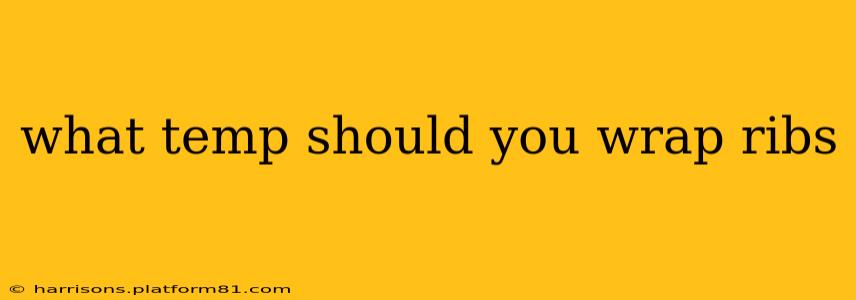What Temp Should You Wrap Ribs? The Ultimate Guide to Perfectly Tender Ribs
Wrapping ribs is a crucial step in achieving that melt-in-your-mouth tenderness we all crave. But the temperature at which you wrap them is key. Get it wrong, and you risk soggy ribs. Get it right, and you'll be rewarded with juicy, flavorful perfection. This guide will break down the ideal temperature for wrapping ribs, along with other crucial factors to consider.
Understanding the Wrapping Process:
Wrapping ribs isn't just about adding moisture; it's about accelerating the cooking process and tenderizing the meat. The steam created inside the foil packet or butcher paper helps break down the collagen, resulting in incredibly tender ribs. However, wrapping too early can lead to mushy ribs, while wrapping too late might not give you the desired tenderness.
The Ideal Temperature for Wrapping Ribs:
Generally, the best time to wrap ribs is when the internal temperature reaches 170-180°F (77-82°C). This is the point where the connective tissues are starting to break down, but the meat still has some structure. Wrapping at this stage allows the steam to work its magic without overcooking the meat.
What Happens if You Wrap Too Early or Too Late?
- Wrapping too early (below 170°F): The ribs may become soggy and lose their smoky flavor. The meat won't have had sufficient time to render its own fat and develop a good bark.
- Wrapping too late (above 200°F): While the ribs will still be tender, they might be slightly drier than if you wrapped them at the optimal temperature. You might also risk overcooking the meat, making it less flavorful.
Factors Affecting the Optimal Wrapping Temperature:
Several factors can influence the ideal temperature for wrapping your ribs:
- Type of Rib: Baby back ribs tend to cook faster than St. Louis-style ribs, so they might need to be wrapped at a slightly lower temperature.
- Cooking Method: The temperature and cooking time will vary depending on whether you're using a smoker, oven, or grill. Adjust accordingly.
- Desired Texture: If you prefer fall-off-the-bone tenderness, you might consider wrapping at a slightly lower temperature and for a longer period. If you prefer a bit more chew, you can wrap at a slightly higher temperature for a shorter duration.
What's the best way to wrap ribs?
Using either heavy-duty aluminum foil or butcher paper are both popular methods. Both provide a sealed environment to trap steam. Butcher paper allows for a bit more breathability, leading some to believe it results in a slightly better bark. Ultimately, the best way to wrap ribs is the method you feel most comfortable with and provides consistently good results.
How long should I wrap my ribs?
The wrapping time depends heavily on your desired level of tenderness and the cooking method. Generally, you'll wrap ribs for 1-2 hours, or until they reach your desired internal temperature (typically around 200-205°F).
Should I spray ribs with apple cider vinegar before wrapping?
Spraying your ribs with apple cider vinegar before wrapping adds a touch of acidity and moisture, further enhancing the flavor and tenderness. This isn't strictly necessary, but it's a popular technique among experienced rib cooks.
What temperature should I finish cooking my ribs after wrapping?
After unwrapping, you'll likely want to finish your ribs uncovered, allowing the bark to crisp up. The ideal finishing temperature is usually around 200-205°F. Use a meat thermometer to ensure they're cooked through.
By carefully monitoring the internal temperature of your ribs and understanding the nuances of wrapping, you can consistently achieve perfectly tender, juicy, and flavorful ribs every time. Remember, practice makes perfect, so don't be afraid to experiment and find what works best for you!
